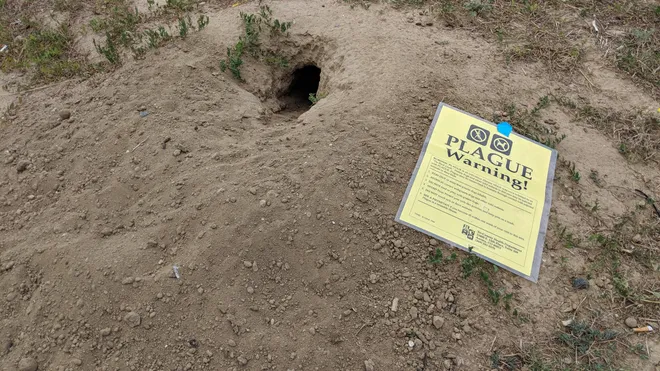Person in Colorado infected with bubonic plague. Here’s what to know

Local health officials said on Monday that an individual in Pueblo County, Colorado, located around 100 miles south of Denver, has contracted bubonic plague.
State and municipal officials recently discovered the case using initial test findings. According to Trysten Garcia, a representative of the Pueblo Department of Public Health and Environment, the disease in question is the bubonic plague, as stated in an email on Tuesday morning. Prior statements were more broad, indicating that it was a “plague.” The infection was first reported on Friday. The department reported that the individual was admitted to the hospital due to bubonic plague, but their health condition has since improved. Garcia stated that due to the local endemicity of the plague, it is challenging to identify the exact source of infection.
The Yersinia pestis bacterium is responsible for the bubonic plague, a disease that caused widespread devastation during historical pandemics in Europe and Asia. The disease is transmitted through fleas, which are frequently carried by wild rodents such as rats and prairie dogs. Plague arises from the transmission of infected fleas by their bites on humans, or through direct contact with an infected animal’s skin.
The majority of human cases in the United States have been reported in the Southwest, specifically in northern New Mexico, northern Arizona, and southern Colorado. Additionally, cases have also been observed in the West, particularly in California, southern Oregon, and far western Nevada. According to the Centers for Disease Control and Prevention, the United States has an average of seven cases of human plague per year.
State health officials stated that a guy from New Mexico died from the plague in March. In February, Oregon officials confirmed the presence of a human case of plague. The Oregon case is believed to have originated from a domestic cat that was infected.
What are the symptoms of bubonic plague?
According to the World Health Organization, symptoms may arise following an incubation period ranging from one day to one week. The plague commonly induces abrupt fever and chills, intense headache, muscular discomfort, as well as nausea and vomiting.
One prevalent indication of the disease is the inflammation and discomfort of lymph nodes, known as buboes, which is the primary characteristic of the bubonic plague. The Mayo Clinic stated that these symptoms appear in the body as edema in the axilla, inguinal region, and neck. Buboes range in size from less than 0.5 inches to approximately 4 inches. According to the CDC, the bubonic plague does not transmit directly between individuals.
Additional variations of plague include pneumonic, which occurs when the bacteria invades the lungs, and septicemic, when the infection invades the bloodstream. Pneumonic plague can be transmitted through inhalation of respiratory droplets emitted by an infected individual. These tiny liquid particles can linger in the atmosphere for up to 60 minutes following a cough from an individual who is infected. Pneumonic plague can also arise when the bacterium from untreated bubonic or septicemic plague disseminates to the lungs. Septicemic plague is not transmitted by human-to-human contact.
According to the World Health Organization (WHO), the mortality rate for bubonic plague ranges from 30% to 60%. Untreated pneumonic plague is lethal.
The Centers for Disease Control and Prevention (CDC) stated that there is currently no available vaccine for the plague in the United States. Individuals experiencing symptoms of plague should promptly seek medical attention. Alicia Solis, a program manager in the Pueblo County public health department, stated that antibiotics are effective in treating plague. However, it is crucial for individuals to seek early medical attention to prevent severe illness or death.
How can you avoid it?
Plague is frequently found in wild rats in the American West. Considering this, health officials in Pueblo County advised individuals to eliminate sites where rodents can conceal and reproduce in close proximity to residences, garages, sheds, or recreational spaces. It is advisable for individuals to prevent their pets from hunting or wandering in places inhabited by rodents, such as prairie dog colonies. Additionally, it is important to frequently administer flea treatment to dogs and cats. Authorities cautioned that flea collars have not been scientifically validated as a reliable method to combat fleas carrying the plague. Officials also cautioned individuals against allowing their pets to sleep in the same bed as them.
It is advisable for individuals to refrain from coming into contact with deceased animals. Officials recommend using insect repellent containing 20 to 30% DEET while handling sick or deceased animals to guard against fleas. Utilize a shovel with an extended handle to lift an animal and transfer it into an outdoor rubbish bag.
‘Black Death’
The presence of plague has been detected in all continents with the exception of Oceania. However, the countries most affected by this disease are the Democratic Republic of Congo, Madagascar, and Peru. Throughout history, the disease has reduced global populations. The World Health Organization (WHO) stated that in the 14th century, the bubonic plague, known as the Black Death pandemic, resulted in approximately 50 million deaths. Over 25% of Europe’s population perished, with certain estimates suggesting even higher figures. Subsequent outbreaks took place in China and India.
Previous instances of widespread disease occurrences in the United States, as well as incorrect understandings or beliefs about them.
While outbreaks of plague have occurred in the U.S. over the decades, the country has not experienced the same magnitude of deaths as other regions. In the year 1900, the plague was brought to port cities like San Francisco by ships infested with rats from areas affected by the disease. Racist public health policies in these cities falsely accused the Chinese community of being responsible for the spread of the disease and being particularly vulnerable to it, as stated by journalist David K. Randall in his book “Black Death at the Golden Gate.” During the mid-1920s, Los Angeles experienced the most significant urban outbreak in the country, resulting in over 30 fatalities. Public health professionals in Southern California at that time attributed the responsibility to the “Mexican district” located directly east of downtown.
However, the responsibility lies with plague-carrying fleas that plagued urban rat species, which then proceeded to infect rural rodent species in the Western regions, establishing a persistent reservoir of infestation that persists up to the present time.
Sources:




